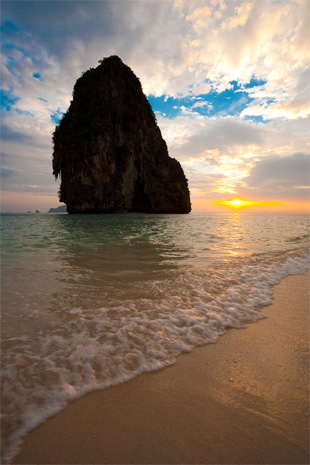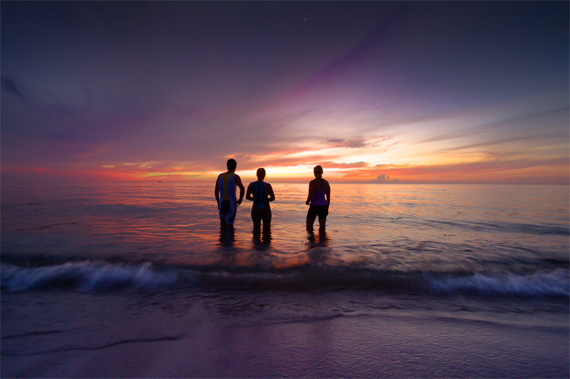One of the most photographed scenes in the world is the beach. The reason?

“Railay Beach Mountain” captured by DailyTravelPhotos
- The locale is beautiful by nature.
- People are usually relaxed and having fun and are not “stiff.”
- A combination of the first two reasons.
This means that beach photography can be either landscape or portrait photography—or a combination of both.
Unlike most other forms of photography, beach photography is about movement. The water is always in motion and if this plays a major part in the composition, you have to be able to balance this movement with the stillness of the rest of the image. The best way to do this is to keep the amount of motion in mind. If there is crashing surf, you will be best served by limiting the amount of surf in your composition or it may overshadow the non moving parts. The less the water movement, the more of it you can include in your compositions.
In beach photography, light is not always your best friend. We are accustomed to seeing bright sunlight in beach photos. But remember that if there is white sand, it can cause a lot of glare and result in stark, high contrast photos that do not capture the feel of the beach. As in all landscape photography, the best time to shoot is in the mornings and evenings when the light hits the sand obliquely, resulting in less glare and harshness and thus warmer colors.
Don’t despair if you are at the beach on a cloudy day. Using the “cloudy” white balance setting on our camera you may be able to capture some great images that show the dramatic contrast between the gray clouds and water. Try taking black and white photos. And if it’s not totally overcast, cloud formations against a blue sky with blue water in the foreground can result in dramatic effects.
When photographing objects or people on the beach, remember that you have a long, flat, unending background. Keep the focus on the subject and allow only as much background as is required for setting the tone or mood of the picture. Trying to do a “half and half” usually results in not doing justice to either the landscape or the subject.
If you’re trying to capture just the openness of the beach, use a wide angle lens. The small lens exaggerates the perspective and results in the background seeming to stretch away into the distance, thereby adding a three dimensional effect to your photo. If you’re shooting up the beach, the wide angle lens will let you keep everything, from the water in front of you to the rocky headland in the distance, in focus. If you want a person or object in the image to add a sense of perspective, remember that the wide angle lens will make the object seem more distant than it really is, so compensate for this by moving closer to it.

“Waiting” captured by Debra Vanderlaan
Beach photography is really all a matter of perspective, and the best way to learn how to use the flatness of the land and water to your advantage is to keep experimenting with distances and depth of field.
About the Author:
Peter Timko writes for Proud Photography (http://www.proudphotography.com/) – an online photography school.
Like This Article?
Don't Miss The Next One!
Join over 100,000 photographers of all experience levels who receive our free photography tips and articles to stay current:






Thanks for the info, Peter. Very useful.